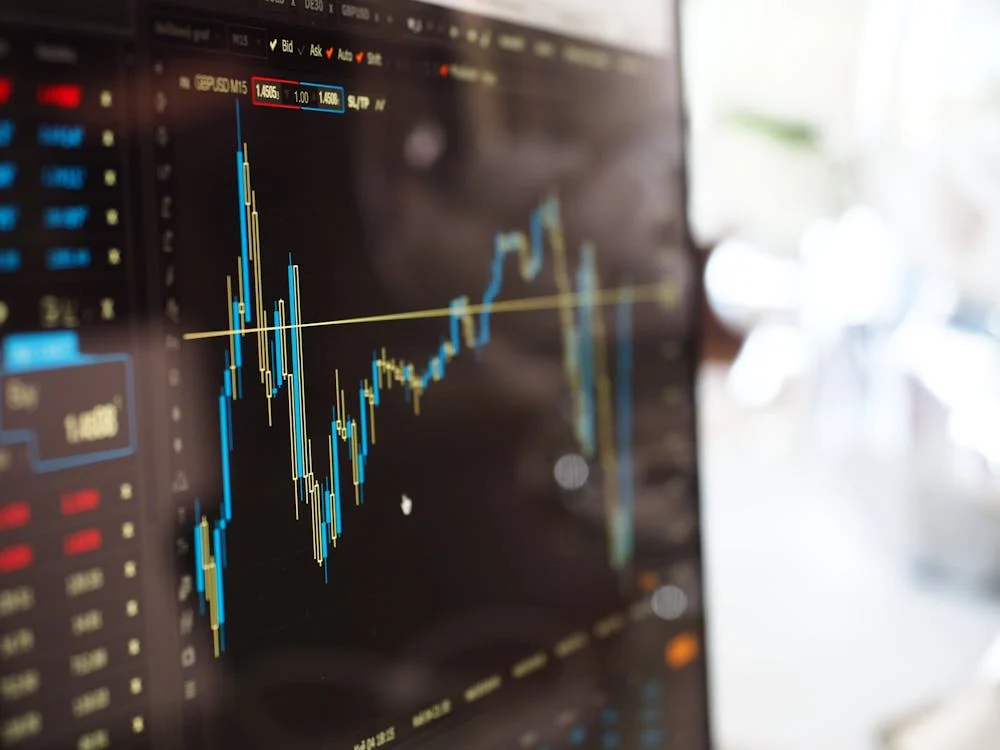Is volatility your friend or foe?
"The stock market is a device for transferring money from the impatient to the impatient." - Warren Buffett
In the world of investing, the word "volatility" is often used to describe fluctuations in the price of an asset. Some investors fear volatility like wildfire, while others see it as an opportunity. But what is volatility and how does it affect your investments? Is it your friend, your enemy or something in between?
In this article, we dive into the world of volatility to understand it better. We will explore what causes it, how it is measured and how to deal with it. We also look at how to turn it to your advantage. Finally, you can decide for yourself whether volatility is a help or a hindrance to your investment strategy.

What is volatility?
Put simply, it shows how much the price of an investment fluctuates. The price of a highly volatile asset fluctuates a lot and quickly, while the price of a low volatile asset remains relatively stable.
Imagine two shares:
- Aktsia A: Its price has fluctuated between 10% and 20% over the past year.
- Aktsia B: Its price has fluctuated between 50% and 100% over the past year.
Share B is clearly more volatile than share A. This means that it is possible to make more profit with share B, but also lose more money.
Volatility is usually measured by with standard deviation. The standard deviation shows how much the return on an investment differs from the average return. The higher the standard deviation, the more volatile the investment.
In addition to the standard deviation, volatility is also measured using the beta coefficients. Beta shows how the price of an investment moves relative to the market index. A beta of 1 means that the investment is moving in the same direction and at the same pace as the market. A beta above 1 means that the investment is more volatile than the market, and a beta below 1 means that the investment is more stable than the market.
What makes shares volatile?
As mentioned, volatility is a measure of stock price fluctuations. But what causes these fluctuations? In fact, there are a whole range of factors at play that influence stock volatility. They can be divided into three:
- Company-specific factors:
- Financial results: A company's profitability, revenues and level of indebtedness have a direct impact on its share price. The price tends to go up when the results are good, and down when the results are bad.
- Management: The competence and strategies of the company's management are also important. The arrival of a new and successful leader can give investors hope and raise the price, while scandals and failed decisions can drive down the price.
- Competition: Firms operating in a competitive sector are often more volatile as it is more difficult to maintain market share and profitability.
- New product developments and innovation: The launch of new products and services can have a significant impact on the share price. Successful products lead to growth and investor interest, while failures do the opposite.
- Mergers and acquisitions: News of mergers and acquisitions can also have a downward impact on share prices, depending on the terms of the deal and investors' expectations.
- Macroeconomic factors:
- Interest rates: Changes in interest rates affect the cost of borrowing and investment, which in turn affects corporate profitability and share prices.
- Inflation: High inflation reduces purchasing power and could lead to a fall in share prices.
- Economic growth: A slowdown or a recession will have a negative impact on company results and share prices.
- Geopolitical events: Wars, political instability and international conflicts create uncertainty and can lead to stock markets falling.
- Natural disasters: Major natural disasters, such as earthquakes and floods, can also affect the economy and stock prices.
- Fear and greed: Investors' emotions, especially fear and greed, play an important role in stock markets. In times of fear, investors sell their shares, leading to a fall in prices. In times of greed, on the other hand, investors buy shares, which leads to a price increase.
- News and media coverage: Positive or negative news about a company or the economy can affect investor sentiment and share prices.
- "Karja instinct": Investors often tend to imitate the behaviour of other investors, which can lead to irrational decisions and market bubbles.
It is the combination of these factors that creates the volatility we see in stock markets. Some stocks are naturally more volatile than others, depending on their sector, their financial condition and investors' expectations. For example, technology stocks tend to be more volatile than consumer discretionary stocks because the technology sector is faster moving and more competitive.
Volatility and risk: two sides of the same coin
Volatility and risk are closely linked. Investments with high volatility are riskier because their value can fall sharply over a short period. However, this does not mean that you should avoid volatility at all costs. In fact, volatility is often an opportunity to earn higher returns.
Think of the stock market, for example. Equities are generally more volatile than bonds, but also offer potentially higher returns. If you're a long-term investor with a high risk tolerance, you can invest in more volatile equities for higher returns. However, if you are a short-term investor or have a low risk tolerance, you should choose more stable investments, such as bonds or index funds.
It is important to understand that risk and return are interlinked. The higher the risk, the higher the potential return. So volatility is not a bad thing in itself. The important thing is to find the right balance between risk and return for you, taking into account your investment objectives and risk tolerance.
How to deal with volatility?
Volatility is an integral part of investing. So it is important to know how to deal with it and control your emotions. Here are some strategies to help you cope with volatility:
Diversify investments across asset classes, sectors and geographical areas. This helps to reduce overall portfolio volatility and risk.
- Long-term investment:
Volatility is higher in the short term, but in the long term markets tend to rise. So if you are a long-term investor, you don't have to worry about short-term fluctuations.
- Regular investment:
Invest regularly in fixed amounts, regardless of market fluctuations. This will help you to buy shares at both higher and lower prices, which will even out your average purchase price over time.
- Emotions verification:
Avoid impulsive decisions based on fear or greed. When markets fall, it is important to stay calm and not sell off your investments. Nor should you buy overvalued shares out of greed.
- Drawing up an investment plan:
Draw up a clear investment plan that takes into account your investment objectives, risk tolerance and time horizon. This will help you make informed investment decisions and avoid emotional decisions.
How to turn volatility to your advantage?
While volatility is often seen as a negative phenomenon, it can also be turned to your advantage by the savvy investor. Here are a few strategies to take advantage of volatility:
- Buying on the dip ("Buy the dip"):
When markets fall and share prices fall, there is an opportunity to buy good shares at a better price. This strategy is suitable for investors with a long-term perspective and a high risk tolerance. However, it is important to remember that buying during a downturn requires careful analysis and caution. Before investing, make sure that company fundamentals are still strong and that the downturn is temporary.
- Dollar-cost averaging:
This strategy consists of investing fixed amounts on a regular basis, regardless of market fluctuations. This helps you buy shares at both higher and lower prices, which evens out your average purchase price over time. This strategy is particularly well suited to beginner investors as it helps to reduce the impact of risk and emotion on investment decisions.
- Selling volatility:
This is a more sophisticated strategy suitable for experienced investors. Volatility selling involves using options and other instruments to earn a premium on market volatility. This strategy can be profitable, but it is also risky, as unexpected market movements can lead to large losses.
- Portfolio rebalancing:
Rebalancing the portfolio means adjusting the portfolio on a regular basis in order to maintain the desired asset allocation. For example, if stock markets have risen and the proportion of shares in your portfolio has increased, you can sell some shares and buy bonds to restore the original allocation. This will help you control the risk and volatility of your portfolio.
- A long-term perspective:
Volatility is higher in the short term, but in the long term markets tend to rise. So if you are a long-term investor, you don't have to worry about short-term fluctuations. The important thing is to focus on your investment goals and remain calm.
Volatility is an integral part of investing. It can be scary, but it also offers opportunities. The key is to understand volatility, know how to manage it and turn it to your advantage.
Summary
We have reached the end of our volatility journey. As we have seen, it is a complex phenomenon with both positive and negative aspects. It is a measure of risk, which shows how much the price of an investment fluctuates. With high volatility comes higher risk, but also higher potential returns.
The causes of volatility are diverse, ranging from company-specific factors to global economic and political events. Investors' emotions and behaviour also play an important role.
It is important to understand that volatility is an integral part of investing. So there is no point in fearing it, but learning to manage it and turn it to your advantage. Diversification, taking a long-term perspective and controlling emotions are important strategies for dealing with volatility.
Ultimately, the "friendliness" of volatility depends on your investment objectives, risk tolerance and time horizon. If you are a long-term investor and can tolerate short-term fluctuations, volatility can be your ally, offering opportunities to buy at favourable prices and earn higher returns. However, if you are a short-term investor or have a low tolerance for risk, volatility is more of an enemy that can damage your portfolio.
It is important to find the right balance between risk and return and to make informed investment decisions. We hope this article has helped you to better understand volatility and to refine your investment strategy.
What next?
- Analyse your portfolio: Assess the volatility and risk of your investments.
- Determine your risk tolerance: How willing are you to take a risk?
- Adjust your investment strategy: Take volatility into account when making your investment decisions.
- Follow the markets: Keep abreast of economic and political events that may affect volatility.
- Learn and grow: Read books, articles and online resources on investing and volatility.
Investing is a continuous process of learning and development. Be patient, be consistent and make informed decisions. Good luck investing!
